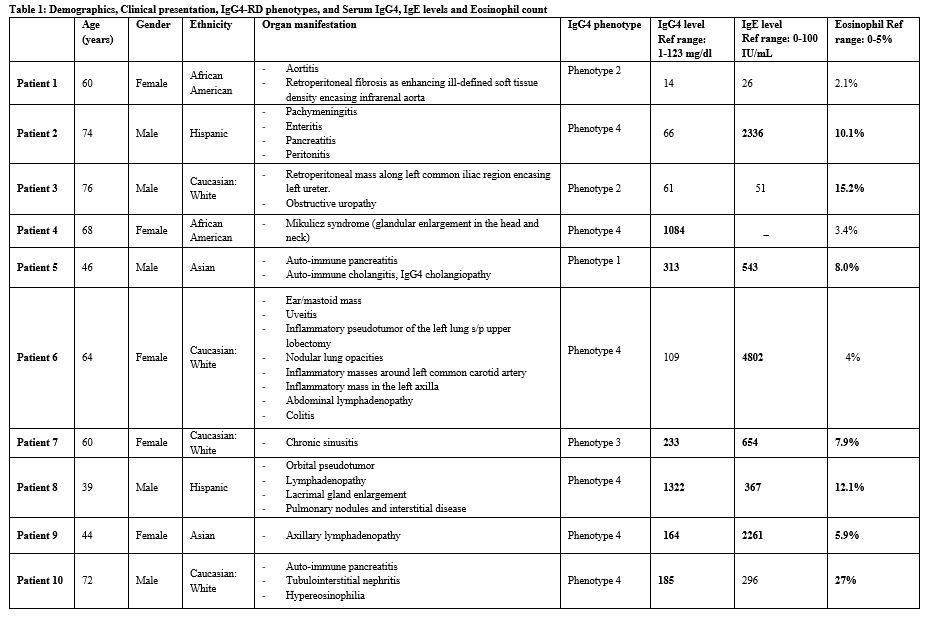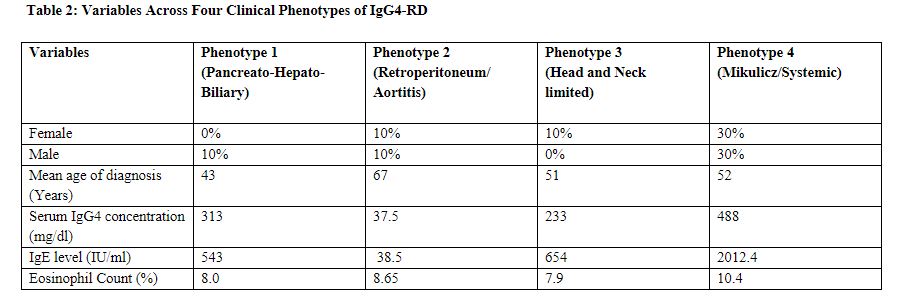Session Information
Session Type: Poster Session C
Session Time: 10:30AM-12:30PM
Background/Purpose: IgG4 – Related Disease (IgG4-RD) is a multisystem immune-mediated fibroinflammatory disorder that can affect nearly any organ and can mimic other inflammatory conditions, malignancy and infections, posing a diagnostic challenge. The clinical presentation of IgG4 –RD has been characterized into four clinical phenotypes such as 1): Pancreato-Hepato-Biliary 2) Retroperitoneal/Aortitis 3) Head and Neck limited and 4) Mikulicz/Systemic. The serum Immunoglobulin G4 (IgG4) level, Immunoglobulin E (IgE) level, and eosinophil count have been described as serological biomarkers in IgG4-RD. There is evidence that higher baseline values of serum IgG4, IgE, and eosinophils can predict the clinical phenotype of IgG4-RD. The aim of our study is to confirm the use of these serological biomarkers across the four clinical phenotypes of IgG4-RD.
Methods: The electronic health record (EHR) database at Houston Methodist Hospital was queried to identify all patients with an ICD-10 diagnosis code of IgG4-RD within the past two years. Out of 36 identified patients with IgG4-RD, a final cohort of 10 patients was isolated from the main single outpatient clinic after excluding patients from peripheral centers and those with overlap of ANCA-associated vasculitis with IgG4-RD. The demographic data and pattern of organ involvement were noted by chart review and patients were classified among 4 phenotypes of IgG4-RD. The serum IgG4, IgE levels and eosinophil count of all patients were noted, and mean values were calculated across the four phenotypes of IgG4-RD.
Results: The mean age of our cohort was 60.3 years, with the oldest at the age of diagnosis representing phenotype 2 (67 years) (Table 1 and Table 2). Gender was equally represented in our population (male 50%, female 50%). 40% of our cohort consisted of individuals who identified as White, 20% as Hispanic, 20% as African American, and another 20% as Asian. Most of our cohort was classified as phenotype 4 (60%), followed by phenotype 2 (20%), phenotype 3 (10%) and phenotype 1 (10%). Our population represented a wide spectrum of organ involvement (Table 1). Mean IgG4 levels differed among phenotypes: 313 mg/dl for phenotype 1; 37.5 mg/dl for phenotype 2; 233 mg/dl for phenotype 3; and 488 mg/dl for phenotype 4 (Table 2). Mean IgE levels also varied: 543 IU/ml for phenotype 1; 38.5 IU/ml for phenotype 2; 654 IU/ml for phenotype 3, and 2012.4 IU/ml for phenotype 4. Eosinophil counts in percent were 8% for phenotype 1; 8.65% for phenotype 2; 7.9% for phenotype 3, and 10.4% for phenotype 4.
Conclusion: Our cohort represents the heterogenous organ manifestation among the four phenotypes described in IgG4-RD. The majority of patients were represented as phenotype 4 with equal distribution among both male and female gender, in contrary to the male predominance previously described. Additionally, our cohort verified higher levels of serum IgG4, IgE, and eosinophil count in phenotype 4 and the lowest levels of IgG4 and IgE in the retroperitoneal/aortitis phenotype 2. This descriptive study confirms the clinical value of IgG4, IgE levels and eosinophil count as serum biomarkers for diagnosis for IgG4-RD and differentiation among each phenotype.
To cite this abstract in AMA style:
Philip V, Daliri S, Aveytia Camacho A, Memon R, Guevara M, Kazzaz S. Descriptive Study on the Use of Serum Levels of Immunoglobulin G4, Immunoglobulin E and Eosinophil Count as Serum Biomarkers Across Four Clinical Phenotypes of IgG4-Related Disease [abstract]. Arthritis Rheumatol. 2024; 76 (suppl 9). https://acrabstracts.org/abstract/descriptive-study-on-the-use-of-serum-levels-of-immunoglobulin-g4-immunoglobulin-e-and-eosinophil-count-as-serum-biomarkers-across-four-clinical-phenotypes-of-igg4-related-disease/. Accessed .« Back to ACR Convergence 2024
ACR Meeting Abstracts - https://acrabstracts.org/abstract/descriptive-study-on-the-use-of-serum-levels-of-immunoglobulin-g4-immunoglobulin-e-and-eosinophil-count-as-serum-biomarkers-across-four-clinical-phenotypes-of-igg4-related-disease/


